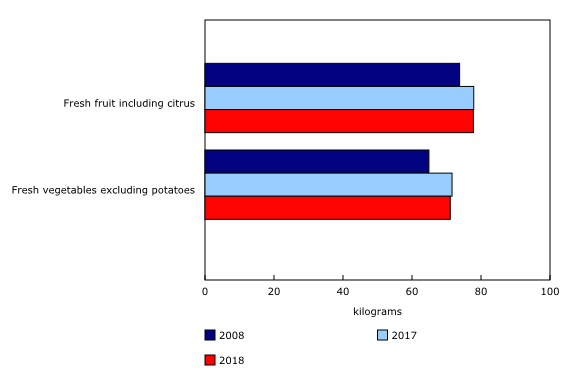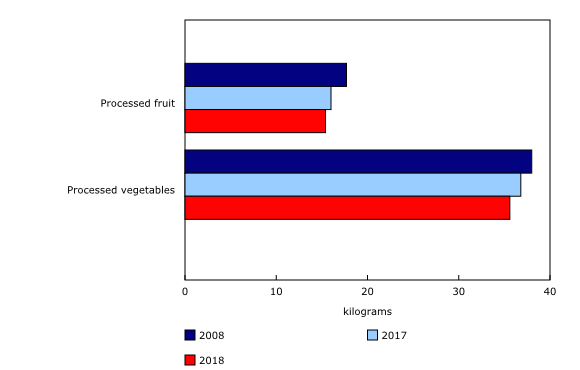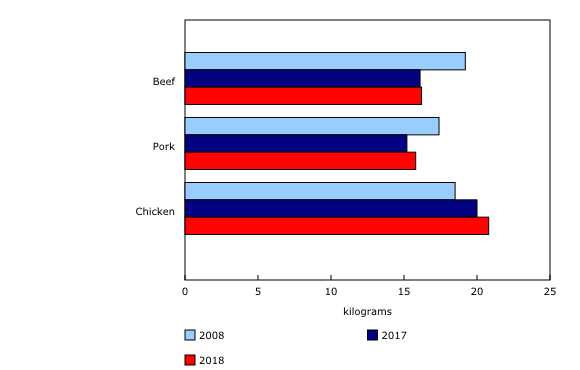Food availability, 2018
Archived Content
Information identified as archived is provided for reference, research or recordkeeping purposes. It is not subject to the Government of Canada Web Standards and has not been altered or updated since it was archived. Please "contact us" to request a format other than those available.
Released: 2019-05-30
The food available for consumption in Canada in 2018 reflected increasing consumer demand for healthier food options, leading to the greater availability of fresh fruit and poultry, and the lower availability of sugar and processed foods.
Food availability is the amount of food that is physically present in a country for human consumption.
More fresh fruit and vegetables available, less processed fruit and vegetables
Total fresh fruit available for consumption, including citrus, rose 5.4% from 2008 to 77.8 kilograms per person in 2018, led by fresh fruit production (+24.2%) and imports (+17.0%).
Conversely, total processed fruit available for consumption decreased 4.0% from 2017 to 15.4 kilograms per person in 2018, 12.8% lower compared with 2008.
Fresh vegetables available for consumption, excluding potatoes, edged down 0.8% from 2017 to 71.1 kilograms per person in 2018, the third consecutive annual decrease, but was still 9.5% higher compared with 2008 due to increased fresh vegetable production and imports.
The availability of processed vegetables declined 6.4% from 2008 to 35.6 kilograms of fresh equivalent per person in 2018.
Chicken continues to lead meat availability
The availability of total poultry for consumption (including chicken, turkey, and stewing hens) was up 4.1% from 2017 to 25.9 kilograms of boneless weight per person in 2018. According to the annual release "Poultry and egg statistics" in The Daily on May 27, 2019, poultry production rose 4.0% in 2018—the ninth consecutive annual rise.
Chicken led the increase, up 12.5% from a decade earlier to 20.8 kilograms available in 2018. The increase in poultry availability for consumption may be attributable to lower price increases for poultry compared with red meat in recent years, as well as for health reasons.
Red meat available for consumption rose 3.9% from 2017 to 34.4 kilograms of boneless weight per person in 2018. The increase in availability in 2018 may be attributable to the lower price of beef and pork, according to the Consumer Price Index. However, beef availability remained 15.8% below 2008 levels, while pork availability was down 9.3% from 2008 to 15.8 kilograms of boneless weight per person.
Egg available for consumption continues to increase
The amount of eggs available for consumption increased 4.1% from 2017 to 21.1 dozens per person in 2018, up almost one-third (+30.5%) from a decade earlier. Meanwhile, egg production rose 29.7% to 800.1 million dozen.
Total cheese and cream continue to increase, while total fluid milk decreases
The amount of total milk available for consumption decreased 1.3% from 2017 to 65.5 litres per person in 2018, down by one-fifth (-20.2%) from 2008. The decline was led by skim milk, down by almost half (-47.4%) from 2008 to 4.57 litres per person in 2018 due to lower production.
Conversely, the availabilities of total cheese increased 13.4% from 2008 to 14.1 kilograms. Production and imports of cheddar cheese and variety cheeses were both up from a decade earlier, while processed cheese was down. The shift away from processed cheese towards other cheeses may be due to consumers choosing healthier food options.
The availability of all cream, including table cream, sour cream, whipping cream and cereal cream, was up from 2008, largely due to increased production.
Less wheat flour available
The volume of wheat flour available for consumption continued to decrease, down 1.4% from 2017 to 56.4 kilograms per person and 10.1% lower compared with 2008, despite a 5.1% production increase over the 10-year period. Imports of wheat flour were down 21.0% from 2008, while exports rose 51.7%.
Refined sugar and sugary drink availability continues to decline
Refined sugar available for consumption continued to decrease, down 2.6% from 2008 and one-fifth (-21.2%) lower compared with 1988. Although the production of refined sugar has increased, the export of sugar and sugar-containing products has risen sharply over the years, leaving less sugar available for domestic consumption.
The availability of most juices for consumption has also trended downward. The lower demand for juice may be due to health-conscious consumers leaning away from sugary drinks.
Soft drink availability declined 2.8% from 2017 to 58.3 litres per person in 2018—one-third (-35.1%) lower compared with 2008. The decrease in soft drink availability was also likely due to consumers choosing drinks that contain less sugar.
Ale availability continues to decline, while wine and spirits rise
The availability of alcoholic beverages per person increased for all alcohol types except ale in 2018. Wine (+3.5%), spirits (+0.6%) and ciders, coolers, and other refreshment beverages (+7.0%) all increased from a year earlier, while ale available for consumption decreased 2.2% to 59.8 litres per person in 2018.
Note to readers
Data on food availability per person for selected products and on the supply and disposition of these products are now available for 2018.
Data presented in this release are compiled from a wide variety of sources, both survey and administrative, from within Statistics Canada, as well as from other sources, including provincial and federal government departments, growers' associations and marketing boards.
The food availability data series is the result of a partnership between Agriculture and Agri-Food Canada and Statistics Canada.
Data were also culled from the Daily release, "Poultry and egg statistics," released on May 27, 2019, and the Consumer Price Index (table 18-10-0002).
The food availabilities in this release have been calculated using population estimates released on January 25, 2019, as a denominator. The population estimates are based on 2016 Census counts adjusted for census net undercoverage and incompletely enumerated Indian reserves, to which are added the population growth estimates for the period from May 10, 2016, to the date of the estimate. The data starting from July 2001 were also revised.
Contact information
For more information, or to enquire about the concepts, methods or data quality of this release, contact us (toll-free 1-800-263-1136; 514-283-8300; STATCAN.infostats-infostats.STATCAN@canada.ca) or Media Relations (613-951-4636; STATCAN.mediahotline-ligneinfomedias.STATCAN@canada.ca).
- Date modified:





